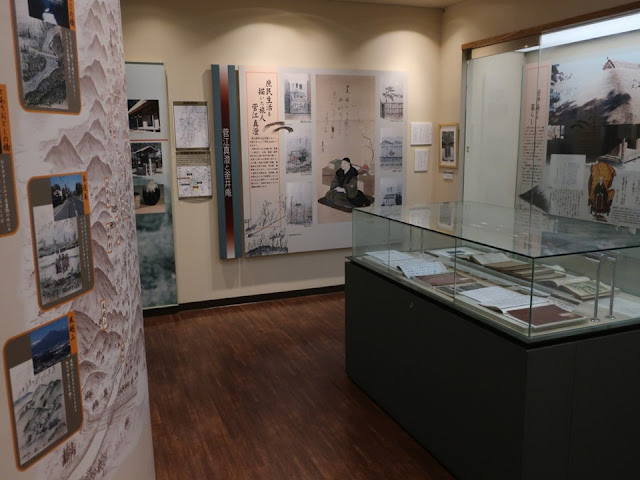Motoseba is in Nagano prefecture of central Japan, and is at the foot of high mountains which are called “Japan Alps”. The museum introduces Sugae (1754-1829) a lot; he was a traveler and wrote local customs in details. He stayed at Motoseba around a year. It was a comfortable place for him. And it is an honor for locals even until now.
長野県塩尻市の北アルプス西麓にある資料館です。江戸時代に、旅をしながら民俗学的な著作を残した菅江真澄(1754-1829)が一年間滞在しました。スポンサーが良かっただけでなく、住み心地も良かったのでしょう。人々の楽しみではありませんが、菅江が滞在したことが誇りになっているのがよく分かりました。
The little museum is at a castle mountain. It was conquered by the famous warlord “Takeda Shingen” in 1555.
城山(妙義山城、鎌倉時代から国人領主の三村氏が支配したが、1555年に武田信玄によって謀殺された)の麓にある小さな資料館です。
The panel at the entrance of the exhibition room introduces rulers of Honseba, visitors of culture in the latter half of the Edo period (1603~1868) and local ceramic industry.
ホールの先、展示室の入口にあるパネルには、本洗馬の支配者、江戸後期に菅江を含む文人墨客が訪れたこと、江戸後期から大正初期にかけて「洗馬焼」が操業されたことが紹介されています。
Then, there is a section of Sugae’s works.
その先では、菅江の功績が説明されています。
He wrote a lot about Nagano prefecture.
長野県だけでも、多くの記録を残していますね。
His books of travels have illustrations. The picture above is a star festival “Tanabata(七夕)” in Honseba. Tanabata dolls are hung under the eaves.
菅江の紀行には、挿絵が入っています。本洗馬の七夕の様子が、描かれています。軒下に平面的な人形が吊されています。
Tanabata decoration was displayed when I visited in July. Sugae stationed the house above (Kamai-an), which was restored in 2001. I like the atmosphere!
彼が滞在した「釜井庵」(2001年修復)には、訪問時(7月)には七夕飾りが吊されていました。彼の絵をベースにした飾りです。雰囲気がありますねえ。
Kamai-an is a classy building beside the museum.
資料館の敷地にある釜井庵は趣がある建物です。
There is a section of Yanagita Kunio, who introduced Sugae to the public. It is said that he is the originator of Japanese folklore.
菅江の価値を見いだした日本民俗学の創始者・柳田國男のコーナーもあります。
The panel above is interesting for me. An idea man established a business model of forestry, and paid off the local government’s (han) debt in the Edo period(1603~1868).
人々の楽しみとは関係ないのですが、目を惹いたパネルです。木曽の木材を扱って、藩の借金を返済したという話です。
Honseba was a local production center of ceramic, because it is far from national ones such as Seto in Aichi prefecture. Large jars are exhibited. I think it was difficult to bring them from the national production areas. However, after the railway was developed, the local ceramic industry declined, because cheap products were brought to Honseba.
洗馬は焼き物が盛んでした。瀬戸などの焼き物の産地から遠かったからです。甕が目立つのは、運びにくかったからでしょうか。鉄道が開通し、安価な瀬戸や美濃製品が流入すると、洗馬の焼き物作りは衰退しました。
There is a junction in Seba post-town which is near Honseba. The left road to Zenkouji (temple) branches from Nakasendou highway which linked Edo (old name of Tokyo) and Kyoto. Many travelers in eastern Japan, who had visited Ise Shrine, walked the road to visit Zenkouji and returned to their village.
近くにある洗馬宿の分去れからは、中山道(右、塩尻宿へ)から、北国往還善光寺道(左、松本へ)が分岐しています。お伊勢参りから関東方面へ下向した旅人の多くは、ここから善光寺へ向かいました。行きの東海道とは別ルートで旅を楽しんだのですね。
Visited
in July, 2023
Official website: https://www.city.shiojiri.lg.jp/soshiki/76/3810.html (in Japanese), accessed in January, 2024
Previous post (museum on Nakasendou highway): Wada
post-town and museums、和田宿と資料館
Next post (Post-town on Nakasendou highway in the same prefecture): Niekawa ex-checkpoint、贄川関所












Comments
Post a Comment